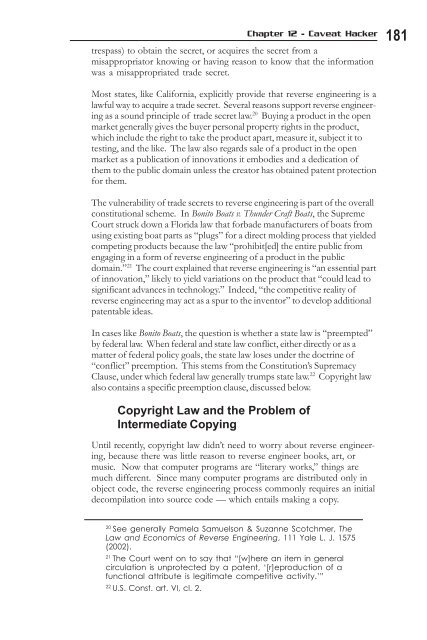Hacking the Xbox
Hacking the Xbox
Hacking the Xbox
You also want an ePaper? Increase the reach of your titles
YUMPU automatically turns print PDFs into web optimized ePapers that Google loves.
Chapter 12 - Caveat Hacker 181<br />
trespass) to obtain <strong>the</strong> secret, or acquires <strong>the</strong> secret from a<br />
misappropriator knowing or having reason to know that <strong>the</strong> information<br />
was a misappropriated trade secret.<br />
Most states, like California, explicitly provide that reverse engineering is a<br />
lawful way to acquire a trade secret. Several reasons support reverse engineering<br />
as a sound principle of trade secret law. 20 Buying a product in <strong>the</strong> open<br />
market generally gives <strong>the</strong> buyer personal property rights in <strong>the</strong> product,<br />
which include <strong>the</strong> right to take <strong>the</strong> product apart, measure it, subject it to<br />
testing, and <strong>the</strong> like. The law also regards sale of a product in <strong>the</strong> open<br />
market as a publication of innovations it embodies and a dedication of<br />
<strong>the</strong>m to <strong>the</strong> public domain unless <strong>the</strong> creator has obtained patent protection<br />
for <strong>the</strong>m.<br />
The vulnerability of trade secrets to reverse engineering is part of <strong>the</strong> overall<br />
constitutional scheme. In Bonito Boats v. Thunder Craft Boats, <strong>the</strong> Supreme<br />
Court struck down a Florida law that forbade manufacturers of boats from<br />
using existing boat parts as “plugs” for a direct molding process that yielded<br />
competing products because <strong>the</strong> law “prohibit[ed] <strong>the</strong> entire public from<br />
engaging in a form of reverse engineering of a product in <strong>the</strong> public<br />
domain.” 21 The court explained that reverse engineering is “an essential part<br />
of innovation,” likely to yield variations on <strong>the</strong> product that “could lead to<br />
significant advances in technology.” Indeed, “<strong>the</strong> competitive reality of<br />
reverse engineering may act as a spur to <strong>the</strong> inventor” to develop additional<br />
patentable ideas.<br />
In cases like Bonito Boats, <strong>the</strong> question is whe<strong>the</strong>r a state law is “preempted”<br />
by federal law. When federal and state law conflict, ei<strong>the</strong>r directly or as a<br />
matter of federal policy goals, <strong>the</strong> state law loses under <strong>the</strong> doctrine of<br />
“conflict” preemption. This stems from <strong>the</strong> Constitution’s Supremacy<br />
Clause, under which federal law generally trumps state law. 22 Copyright law<br />
also contains a specific preemption clause, discussed below.<br />
Copyright Law and <strong>the</strong> Problem of<br />
Intermediate Copying<br />
Until recently, copyright law didn’t need to worry about reverse engineering,<br />
because <strong>the</strong>re was little reason to reverse engineer books, art, or<br />
music. Now that computer programs are “literary works,” things are<br />
much different. Since many computer programs are distributed only in<br />
object code, <strong>the</strong> reverse engineering process commonly requires an initial<br />
decompilation into source code — which entails making a copy.<br />
20 See generally Pamela Samuelson & Suzanne Scotchmer, The<br />
Law and Economics of Reverse Engineering, 111 Yale L. J. 1575<br />
(2002).<br />
21 The Court went on to say that “[w]here an item in general<br />
circulation is unprotected by a patent, ‘[r]eproduction of a<br />
functional attribute is legitimate competitive activity.’”<br />
22 U.S. Const. art. VI, cl. 2.


